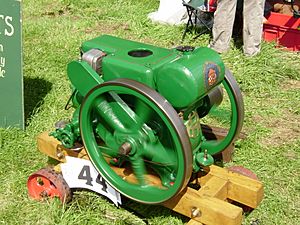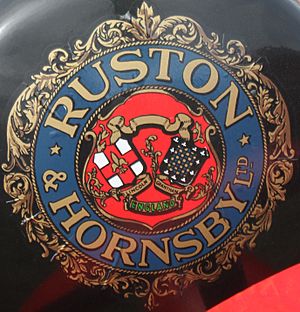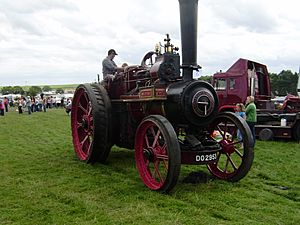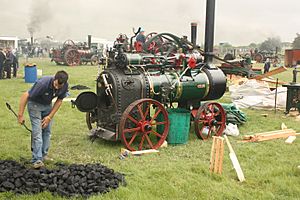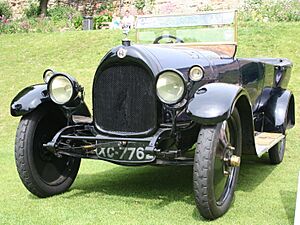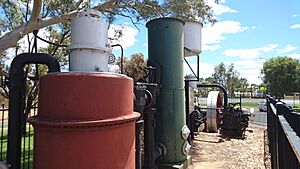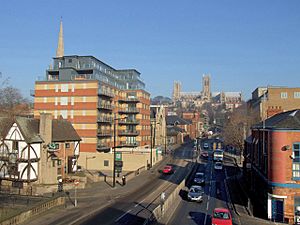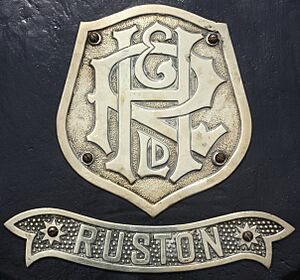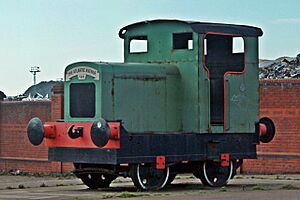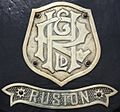- This page was last modified on 17 October 2025, at 10:18. Suggest an edit.
Ruston & Hornsby facts for kids
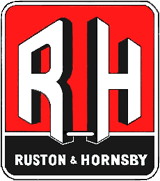
Ruston & Hornsby logo
|
|
| Private | |
| Industry | Engineering |
| Fate | Purchased by English Electric |
| Predecessor | Ruston, Proctor and Company |
| Founded | 1918 |
| Headquarters | Waterside South, Lincoln, England |
| Products | Diesel engines, Locomotives, Steam engines, Gas turbines |
| Parent | English Electric (1966–1968) GEC (1968–2003) Siemens (2003–) |
| Subsidiaries | Ruston-Bucyrus |
Ruston & Hornsby was a famous company in Lincoln, England. It started in 1918 and made many different kinds of machines. They were best known for building diesel locomotives (train engines) and powerful steam shovels. They also made cars, steam locomotives, and various types of internal combustion engines. Later, they even built gas turbines. Today, the company is part of Siemens.
Contents
The Beginning of Ruston & Hornsby
The story of Ruston & Hornsby began in 1840 with a company called Proctor & Burton. They were engineers who built and fixed mills. In 1857, Joseph Ruston joined them, and the company became Ruston, Proctor and Company.
They started building tank locomotives (small steam trains) in 1866. One of their trains was even shown at a big exhibition in Paris in 1867! They also built five special 0-6-0 tank engines for the Great Eastern Railway. Some of these engines lasted a very long time, until 1952.
During the First World War, Ruston, Proctor and Company helped with the war effort. They built some of the very first tanks and many airplanes, including the famous Sopwith Camel.
Ruston & Hornsby is Formed
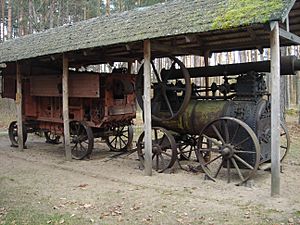
A Ruston & Hornsby threshing machine from the 1800s
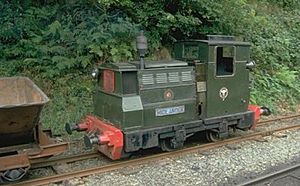
Talyllyn Railway No. 5, built by Ruston & Hornsby in 1940
On September 11, 1918, Ruston, Proctor and Company joined with another company called Richard Hornsby & Sons. Together, they became Ruston and Hornsby Ltd (R&H). Richard Hornsby & Sons was a leader in making heavy oil engines. They had been building them since 1891, even before Rudolph Diesel's engine was sold.
Ruston & Hornsby made many different types of engines. They built oil and diesel engines, from small ones to huge industrial engines. You can still see some of their engines in museums today, like the Anson Engine Museum and the Internal Fire - Museum of Power. The company also started making petrol engines.
Steam Power and War Work
For many years, Ruston & Hornsby built steam engines and portable steam engines, mostly for farms. They also made steam rollers, which were used to build roads.
During the First World War, the company built about 2,750 airplanes and 3,000 airplane engines. They built 1,600 Sopwith Camel planes! They also built the largest bomb of the war. One of their directors, Frederick Howard Livens, had a son named William Howard Livens. He invented special weapons like the Livens Projector to help the army.
After the war, in 1919, a director named Colonel J.S. Ruston wanted to build affordable homes for his workers. He planned a "garden suburb" called Swanpool Garden Suburb in Lincoln. It was meant to have houses, a technical school, a church, and even swimming baths. However, only 113 of the planned homes were built.
The Ruston-Hornsby Car
After the First World War, Ruston & Hornsby tried making cars. They built two types of the Ruston-Hornsby car between 1919 and 1924. These cars were very heavy and expensive. Because of this, they didn't sell as many as they hoped. About 1,500 cars were made. Today, Siemens still has two of these cars at their Lincoln site.
Second World War Contributions
During the Second World War, Ruston & Hornsby continued to play a role. In 1944, when the German army headquarters near Paris was captured, it was found to be powered by Ruston diesel engines! The company also built the first version of the Valiant tank and the Matilda II tank.
Diesel Engines and Gas Turbines
Ruston & Hornsby was a big producer of diesel engines for land and sea. They started building diesel locomotives in 1931 and continued until 1967. They were also pioneers in developing gas turbines from the 1950s onwards. These gas turbines were used in industries and could produce up to 10,000 kilowatts of power. In the 1960s, they were Europe's top supplier of land-based gas turbines.
A key person in starting gas turbine production was Bob Feilden CBE, who joined the company in 1946. The first gas turbines were made in 1952. In 1950, they opened the Beevor Foundry, which was said to be the biggest foundry in Europe.
By the 1950s, they were making a new turbine every two weeks! They sold their 1,000th gas turbine in 1977. They even won a special award, the MacRobert Award, in 1983 for their Tornado gas turbine.
Dr. Waheeb Rizk, the company's chairman, helped develop a special "W layout" for gas turbine power stations. These were used as emergency power plants for the National Grid to prevent power outages. Ruston & Hornsby built the first gas turbine to burn North Sea gas. In 1981, they won a big order to power the Urengoy–Pomary–Uzhgorod pipeline in Siberia.
Boilers and Energy Projects
Until the late 1960s, Ruston & Hornsby also made Thermax boilers. They sold this part of their business in 1968.
In 1957, Ruston & Hornsby was the first company to put an experimental gas turbine on a main Royal Navy ship, HMS Cumberland.
In 1959, they opened a new type of power plant in East London that used waste sewage gas to power eight turbines. This plant produced 18,000 horsepower!
The company was also a leader in combined heat and power (CHP) schemes. These systems use the heat from power generation to provide heating, making them very efficient. They started this technology in Italy in 1956. By the late 1960s, Ruston & Hornsby CHP units were used all over the world. They won the Queen's Award for Enterprise for their export success in 1977, 1978, and 1982.
The large Singer factory in Scotland and the King Faisal Specialist Hospital in Saudi Arabia were powered by Ruston turbines. Even Whitehall in London, where many government buildings are, uses a CHP unit built by the company.
Changes in Ownership
Paxman and English Electric
In 1940, Ruston & Hornsby bought a major share in the Paxman diesel engine company. During the war, Paxman built 4,000 diesel engines that powered all the British-built tank landing craft used on D-Day.
In November 1966, a larger company called English Electric bought Ruston & Hornsby. This made them Britain's second-largest diesel engine group. After this, Ruston & Hornsby became a part of English Electric. The production of large Ruston engines moved to another factory, and smaller engines became part of the Dorman Diesel range. The gas turbine technology stayed in Lincoln.
GEC and Siemens
In 1968, General Electric Company (GEC) bought English Electric, which included Ruston & Hornsby. By the end of 1969, the Lincoln factory was known as Ruston Gas Turbines.
Later, GEC merged its engineering division with a French company called Alsthom, becoming GEC-Alsthom in 1989. This company later changed its name to Alstom in 1998. During this time, the Lincoln factory was called EGT (European Gas Turbines).
Finally, in 2003, Alstom sold its gas turbine division to Siemens. The gas turbine business is still in the old Ruston factory in Lincoln today.
Lincoln's Economy
In the late 1960s and early 1970s, many engineering companies in Lincoln struggled. However, the GEC group of companies in Lincoln, including Ruston, managed to survive and even grow. This was partly because 80% of their engines were sold to other countries, and the North Sea oil industry was growing fast, needing lots of power.
Manufacturing Plants
The original Ruston factory in Lincoln focused on making gas turbines from 1967 onwards. It became the main office for Ruston Gas Turbines. In 2009, Siemens announced that some gas turbine work would move abroad, but the Lincoln site would remain an important part of their operations.
Another factory, the Vulcan Foundry in Merseyside, was known as Ruston Diesels until 2002. It was later taken over by MAN Diesel.
What Rustons Focused On
Rustons, in all its different forms, was always mainly an engine producer. You could say they built machines just so they could sell their powerful engines inside them!
Preserved Locomotives
Many Ruston & Hornsby locomotives are still around today and can be seen on Heritage railways in different countries. These old trains are kept in working order for people to enjoy.
Here are some places where you can find preserved Ruston & Hornsby locomotives:
Australia
- Bennett Brook Railway, Perth
- Don River Railway, Devonport
Denmark
- Nordsjællands Veterantog, Denmark
France
- Train de Rillé, France
Indonesia
- Cepu Forest Railway, Indonesia
Ireland
- Railway Preservation Society of Ireland, Whitehead
Israel
- Israel Railway Museum, Haifa
New Zealand
- Blenheim Riverside Railway, New Zealand
- Glenbrook Vintage Railway, New Zealand
- Plains Vintage Railway, New Zealand
- Pleasant Point Museum and Railway, New Zealand
Norway
- Thamshavn Line, Norway
United Kingdom
- Abbey Pumping Station, Leicester
- Amberley Museum Railway, West Sussex
- Bo'ness and Kinneil Railway, Scotland
- Bristol Harbour Railway, Gloucestershire
- Caledonian Railway, Scotland
- Cambrian Heritage Railways, Shropshire
- Colne Valley Railway, Essex
- Corris Railway, Mid-Wales
- Derwent Valley Light Railway, York
- Ecclesbourne Valley Railway, Derbyshire
- Embsay and Bolton Abbey Steam Railway, Yorkshire
- Epping Ongar Railway, Essex
- Fife Heritage Railway, Fife
- Foxfield Railway, Staffordshire
- Great Central Railway (Nottingham), Nottingham
- Helston Railway, Cornwall
- Leadhills and Wanlockhead Railway, Scotland
- Leighton Buzzard Light Railway, Bedfordshire
- Lincolnshire Wolds Railway, Lincolnshire
- Mid-Norfolk Railway, East Anglia
- Mid-Suffolk Light Railway, East Anglia
- Midland Railway, Butterley, Derbyshire
- Moseley Railway Trust, Staffordshire
- Mountsorrel Railway, Leicestershire
- Northampton & Lamport Railway, Northamptonshire
- Old Kiln Light Railway, Surrey
- Purbeck Mineral and Mining Museum, Dorset
- Rutland Railway Museum, Rutland
- Scottish Industrial Railway Centre, Ayrshire
- Severn Valley Railway, Shropshire/Worcestershire
- Steeple Grange Light Railway, Derbyshire
- Strathspey Railway, Inverness-shire
- Talyllyn Railway, North-West Wales
- Welsh Highland Railway, Gwynedd
- Whitwell & Reepham Railway Norwich
- Yaxham Light Railway, Norfolk
- Plym Valley Railway, Plymouth
There's also a preserved marine engine:
- The Ross Tiger is a fishing trawler from 1957. It has a 7-cylinder diesel Ruston engine, plus a Ruston winch engine and two generator engines.
Images for kids
-
Ruston & Hornsby threshing machine (left) 2nd half of the 19th century (SN 27894) at Riga open-air museum (Latvia)
-
Talyllyn Railway No. 5, built by Ruston & Hornsby in 1940
-
Rushton 2cyl gas engine, at Dareton, New South Wales (Wentworth Region). The coke gas producer is at left, that feeds the 2cylinder 128 horsepower (95 kW) engine with 6 ton flywheel. This ran the irrigation pump to draw water from the Murray River for the Coomealla Irrigation Area. It is now an exhibit in a park in the town.
-
"Murray" a 2 ft (610 mm) gauge locomotive, on the Blenheim Riverside Railway
-
"County School" a standard gauge locomotive, on the Mid-Norfolk Railway

